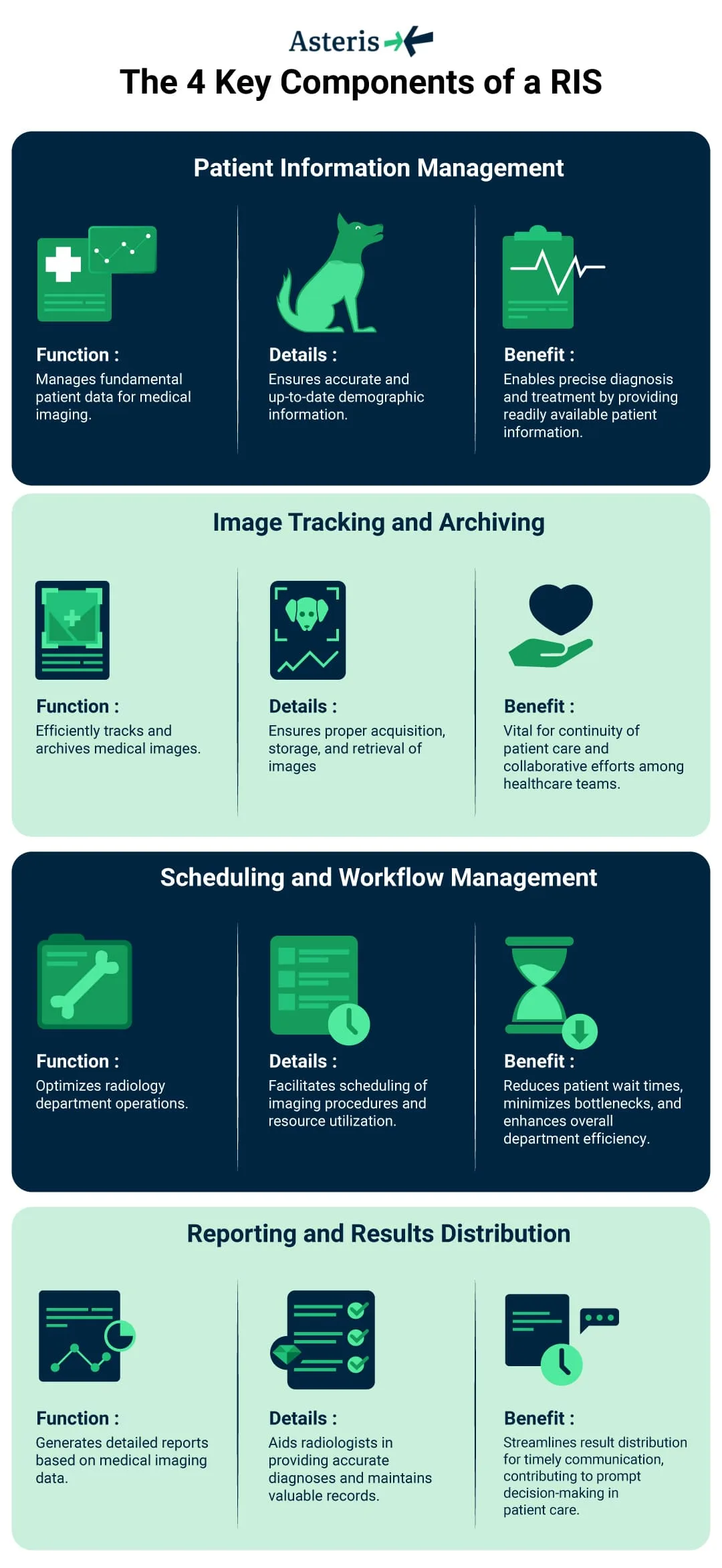In healthcare technology, integrating sophisticated systems has become paramount for effective patient care and streamlined medical processes. One such integral component in the realm of medical imaging is the Radiology Information System (RIS). This article aims to comprehensively answer questions like, what is a Radiology Information System? What are its key components, functions, benefits, challenges, and real-world applications? And what does the future of this technology look like? Let us get started.
Definition of Radiology Information System (RIS)
At its core, a Radiology Information System (RIS) is a specialized software system designed to manage and organize medical imaging data within radiology departments and facilities. This comprehensive system plays a pivotal role in handling various aspects of medical imaging, from patient information management to the efficient tracking and archiving of images. The significance of RIS in the healthcare industry cannot be overstated. As medical imaging continues to be a crucial diagnostic tool, efficient systems to manage the associated data become imperative. RIS serves as the backbone of radiology departments, ensuring a seamless workflow and contributing to improved patient care.
The journey of Radiology Information Systems has been marked by continuous evolution, adapting to technological advancements and the ever-growing demands of the healthcare landscape. As healthcare imaging solutions have significantly optimized, RIS can be considered the front-runner in this revolutionary process. From its early days as a standalone system to its integration with other healthcare platforms, RIS has come a long way in enhancing the efficiency of medical imaging processes.
What are the 4 Key Components of a Radiology Information System?
Now that you have a brief answer to the question, what is a Radiology Information System? Let us look further into the nuances regarding the components or roles performed by RIS.
Patient Information Management
One of the fundamental functions of RIS is patient information management. This includes basic demographic data and details relevant to medical imaging procedures. The system ensures accurate and up-to-date information is readily available to healthcare professionals, contributing to precise diagnosis and treatment.
Image Tracking and Archiving
Efficient image tracking and archiving are critical aspects of any Radiology Information System. RIS ensures that medical images are acquired and stored appropriately and easily retrievable when needed. This function plays a vital role in the continuity of patient care and aids in the collaborative efforts of healthcare teams.
Scheduling and Workflow Management
RIS’s scheduling and workflow management capabilities are essential for the smooth operation of radiology departments. The system facilitates the scheduling of imaging procedures, optimizing the utilization of resources and reducing wait times for patients. Workflow management ensures a logical progression of tasks, minimizing bottlenecks and enhancing overall efficiency.
Reporting and Results Distribution
RIS facilitates the generation of detailed reports based on the analysis of medical imaging data. These electronic medical reports aid radiologists in providing accurate diagnoses and serve as valuable records for future reference. The system streamlines the distribution of results, ensuring timely communication with referring physicians and contributing to prompt decision-making in patient care.
To learn about the key factors to consider while choosing a veterinary PACS solution, read this.
What are the major benefits of Using a Radiology Information System?
Among the many benefits of Radiology Information Systems, we have chosen a few that make the healthcare sector more efficient. Some of the benefits include:
Integration with Picture Archiving and Communication System (PACS)
The synergy between Radiology Information Systems and Picture Archiving and Communication Systems (PACS) is a hallmark of modern medical imaging. PACS and RIS systems work in tandem to provide a comprehensive solution for managing digital images. While RIS focuses on administrative and workflow functions, PACS specializes in storing and retrieving medical images, creating a unified platform for seamless operation.
Automation of Administrative Tasks
One of the notable features of RIS is its ability to automate various administrative tasks within radiology departments. From appointment scheduling to billing and invoicing, RIS streamlines these processes, reducing the burden on administrative staff and minimizing the likelihood of errors. Automation contributes to overall operational efficiency and ensures compliance with regulatory requirements.
Support for Diagnostic Decision-Making
Radiologists rely on accurate and timely information to make informed diagnostic decisions. RIS provides comprehensive support by coherently organizing patient data, images, and reports. The system’s intuitive interface allows radiologists to navigate through information seamlessly, contributing to quicker and more accurate diagnoses.
Improved Efficiency in Radiology Departments
One of the primary benefits of implementing a Radiology Information System is the significant improvement in the overall efficiency of radiology departments. By automating tasks, optimizing workflow, and ensuring accurate data management, RIS enables healthcare professionals to focus more on patient care and less on administrative complexities.
Enhanced Patient Care and Safety
The benefits of RIS extend beyond administrative efficiency. The system enhances patient care and safety by providing quick access to accurate medical information. Timely and precise diagnoses, facilitated by organized data and efficient workflow management, improve outcomes and increase patient satisfaction.
Streamlined Workflow and Resource Utilization
Radiology Information Systems are pivotal in streamlining workflow and optimizing resource utilization. Efficient scheduling, automated administrative processes, and seamless integration with other systems reduce bottlenecks and enhance the overall productivity of radiology departments. It, in turn, leads to better resource allocation and improved patient service.
Challenges in Implementing and Using RIS
In this section, let us look at the common challenges that come in the way of Radiology Information System implementation. These challenges have been met with prompt and functional solutions depending on different capacities to implement this system successfully. Some of the common challenges and concerns include:
Data Security and Privacy Concerns
As with any system dealing with sensitive medical information, data security and privacy are paramount in implementing Radiology Information Systems. Ensuring compliance with healthcare regulations and robust security measures are essential to mitigate potential risks and safeguard patient confidentiality.
Integration with Electronic Health Records (EHR)
The integration of RIS with Electronic Health Records (EHR) is a challenge that healthcare organizations often face. The seamless exchange of information between these systems is crucial for comprehensive patient care. Overcoming interoperability challenges and establishing effective data-sharing protocols are vital considerations in optimizing the synergy between RIS and EHR.
Training and Adoption Challenges
The successful implementation of any new system hinges on the readiness and acceptance of the end-users. Training healthcare professionals to effectively use RIS and fostering a culture of adoption are challenges that organizations may encounter. Addressing these challenges is essential to maximize the benefits of RIS in a healthcare setting.
Future Trends in Radiology Information Systems
The future of Radiology Information Systems is closely tied to advancements in artificial intelligence (AI) and machine learning (ML). Integrating these technologies into RIS promises enhanced image analysis, automated reporting, and predictive analytics. This evolution is expected to elevate the efficiency and accuracy of diagnostic processes. As healthcare systems evolve, the need for interoperability becomes increasingly crucial. The seamless integration of RIS with other healthcare systems, including EHR, PACS, and laboratory information systems, is a trend that promises to create a more cohesive and interconnected healthcare environment. The landscape of medical imaging and information management is dynamic, with continuous technological advancements shaping the trajectory of Radiology Information Systems.
To learn about the success metrics that matter for your veterinary practice, read this.
About Asteris Keystone
The Asteris Keystone Software Suite enables veterinary practices across a wide range of specialties to utilize the benefits of PACS veterinary radiology software. This integrated suite of solutions delivers unmatched speeds, convenience, and security to your veterinarian practice.
Keystone Omni is compatible with any imaging device – no matter how diverse your hardware is, our software caters to your image management needs. Our software has served zoos, universities teaching veterinary disciplines, and clients serving ranchers and farmers. Our system ensures that you can conveniently provide excellent care to any type of animal – all under one roof.
Key features of Keystone Omni:
- Secure: Images are encrypted before being stored locally and in the Asteris cloud. You can also store images and report files.
- Fast: Rapid image transfer rate helps you be more efficient so you can keep up with a demanding workflow.
- Automated: Automatic archival, instant backup, and automated population of patient information at the imaging device.
- Dynamic: Order an exam, automatically capture billing, and access images with a pre-populated customer record.
Whatever the nature of your practice, Keystone Omni’s flexibility and specialized functionality assist in the diagnosis and treatment of any type of animal in any scenario. To learn more, get in touch with our team now!
Book a Demo of Keystone Omni Now
Submit images directly through Asteris Keystone or via our free and simple Asteris Keystone Community application.
Blog
the latest Updates from Asteris
If you like this post you might like this
Subscribe to our newsletter
don't miss out the updates
from asteris
Sign up to our newsletter to stay in the loop.


